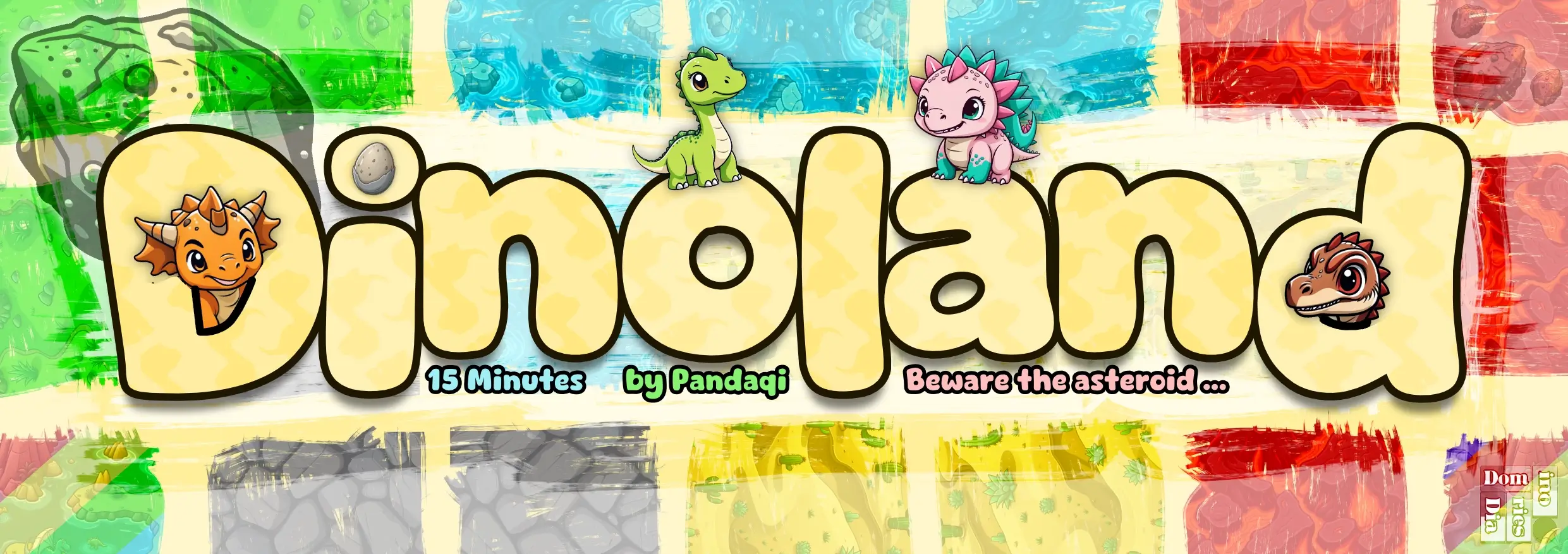Create the Asteroid Deck: pick 10 random Asteroid Tiles, shuffle, and place faceup on the table.
Create a Domino Deck: grab all Domino tiles, shuffle, and place facedown on the table.
Deal every player a hand of 4 dominoes. Each player also picks a color and receives all pawns of that type.
Finally, prepare the map.
- Place a random domino in the center of the table.
- Place one Asteroid Crosshairs tile to its left, and one above it, pointing to it.

The game ends when the Asteroid Deck runs out ( = all its cards have been revealed). Check the impact of the asteroid, then calculate the final scores.
If playing cooperative, higher is better. If playing competitive, highest score wins.
From start player, take clockwise turns until done.
On your turn, simply play a domino from your hand (and then refill your hand). You may also claim: place a pawn inside any unclaimed Area (see scoring).
Only two restrictions apply: the domino must be adjacent to the current map and can’t overlap anything.
Then take the action of each dinosaur on the tile (if it has one).
- Triceratops: move the Asteroid Crosshairs in the direction indicated by the arrow. If it moves off the map, it wraps around to the other side.
- Velociraptor: reveal the top card of the asteroid deck.
- Brachiosaurus: look at the next 5 Asteroid Tiles.

Let’s define an Area as the largest possible group of connected tiles with the same terrain.
Each Area scores its size (number of rectangles inside it) multiplied by the number of dinosaurs inside.
Each player only scores Areas that they have claimed ( = one of their Pawns is inside that area.)
It can happen that Areas merge over time: two Areas that used to be separate, and were claimed, are connected at some point. This is fine! All owners score that Area.

When the Asteroid Deck runs out, the asteroid crashes into your map.
- It hits the location where both its crosshairs meet.
- That square and all 8 neighboring squares (horizontal, vertical and diagonal) are “destroyed”.
- (The map doesn’t wrap like the crosshairs, which makes checking the impact far simpler.)
- If a square is destroyed, its entire Area (see scoring) must be ignored when scoring.

Played the base game and ready for more? Or looking to tweak the game to fit your playing group better? Check out these variants and expansions!
The “simpler” variants are great for a first game with very young kids, because they make the game extremely simple to teach and play.
Variant (simpler): reduce the range of the Asteroid to only the single square that it hits.
Variant (simpler): ignore the Brachiosaurus action ( = look ahead in the Asteroid Deck). This dinosaur simply has no action.
Variant (duration): to change the duration of the game, change the size of the Asteroid Deck. (As expected, bigger deck = longer game.)
Variant (duration): instantly end the game as soon as all players have placed all their Pawns.
Variant (harder): don’t allow Herbivores and Carnivores to be in the same Area!
- All dinosaurs in this game are Herbivores, except the Velociraptor (which brings the Asteroid closer).
- This also restricts what the Wildcard Dinosaur (from the expansion) can be. That is, if you place a wildcard in an area with only Herbivores, then you can only make it be a Herbivore type. (And if inside an area with only Carnivores, it can only be a Velociraptor.)
Variant (even harder): don’t allow more than 1 type of Dinosaur in the same Area!
This is an “upgrade” to the base game that doesn’t require extra material. From now on, we’ll use those eggs you see!
During setup, make sure you include some Egg Hatch Asteroid tiles. (A good distribution to start is 6 regular, 4 hatch.)
When the Egg Hatcher Asteroid is revealed,
- Find all claimed eggs. (All egg icons inside an Area claimed by a player.)
- For each one, its owner must now hatch the egg. (Do so in clockwise order, starting from the current active player.)
- This means they place a domino from their hand on top of the egg, which must show a dinosaur in the spot where the egg previously was. (It is optional to take the corresponding dinosaur action.)

If it’s possible, you must hatch. Otherwise, nothing happens.
An Area that is shared ( = claimed by multiple Players) can’t hatch eggs anymore.
This expansion adds two more terrain types: desert and wildcard (which can be any terrain, or rather “all of them at the same time”).
It also adds two more dinosaurs.
- Stegosaurus = look at another player’s hand OR replace your entire hand with new dominoes from the deck
- Wildcard = represents any dinosaur type you want

This expansion adds a new deck: the Impact Cards. During Setup, draw a random Impact Card and place it faceup on the table.
This card tells you how to handle the Asteroid Impact at the end of the game! (What gets destroyed and perhaps another rules tweak.)
This expansion adds many more Asteroid Cards with special actions on them.
- During Setup, swap any regular Asteroid Tiles for random ones from this expansion.
- During Gameplay, whenever you reveal such a tile, execute its action!
- Any actions are done by whoever revealed the tile.
